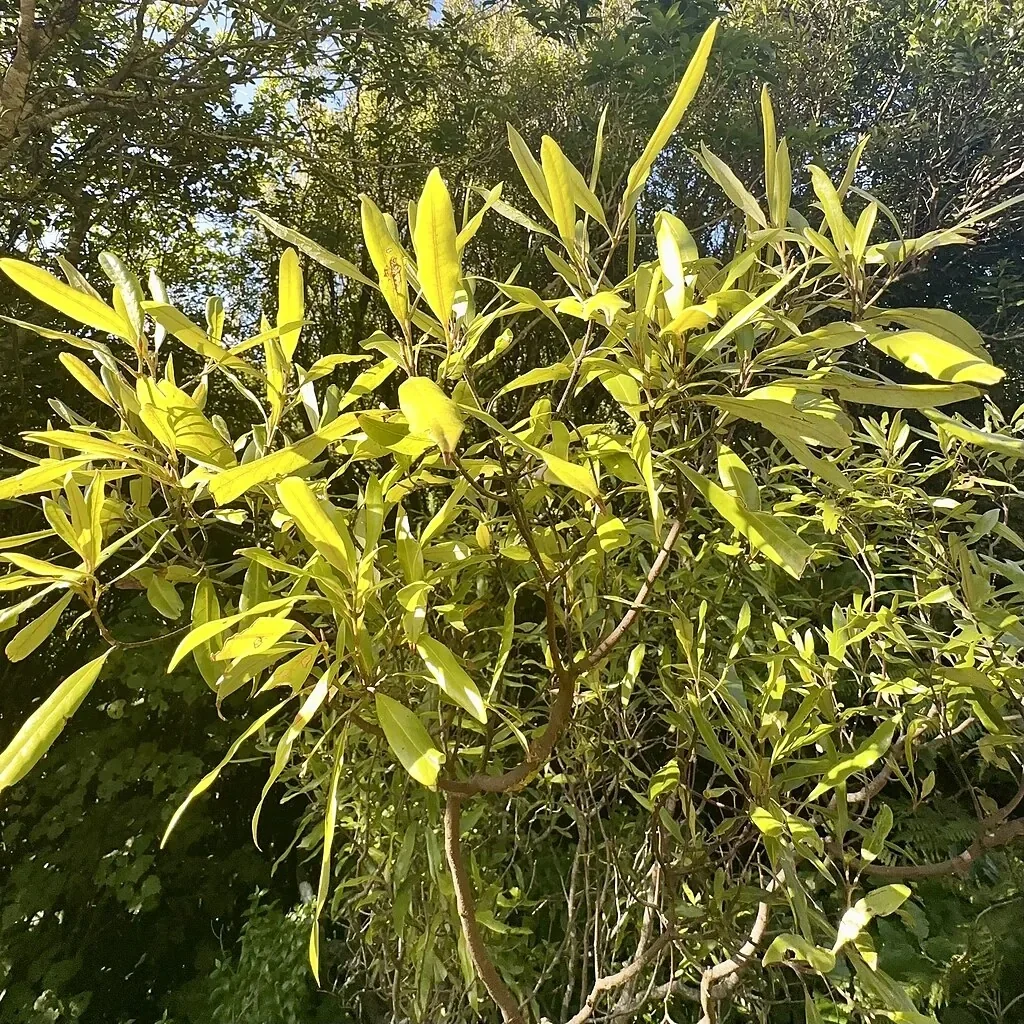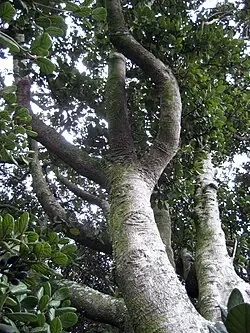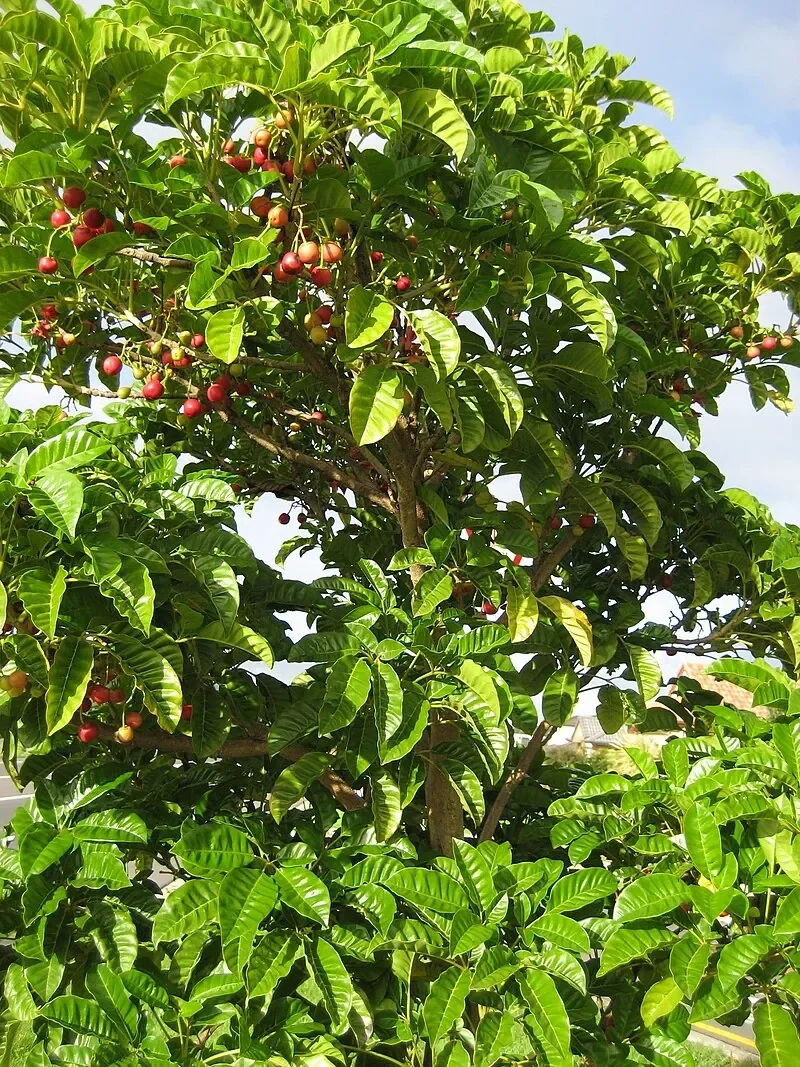
Tawa
Beilschmiedia tawa
Explore more NZ native plant guides in our index .
Introduction
About Tawa
Beilschmiedia tawa , commonly known as Tawa, is a prominent evergreen tree endemic to New Zealand. It is characterized by its tall, straight trunk, smooth dark bark, and graceful canopy of willow-like leaves. Tawa is a dominant species in many lowland forests, particularly in the North Island, and is highly valued for its timber, edible fruits, and ecological importance.

Plant Description
Botanical Features
Beilschmiedia tawa , or tawa, is a tall, evergreen forest tree with a straight, smooth trunk and a dense, broad crown. Its leaves are willow-like, long and slender, with a pale, waxy underside. The tree produces small, inconspicuous greenish flowers, which are followed by large, dark purple, plum-like fruits. These fruits are a crucial food source for native birds, particularly the kererū, which is the primary disperser of its seeds.
Quick Facts
Tree Summary
| Scientific Name | Beilschmiedia Tawa |
|---|---|
| Height | 10-30 m |
| Spread | 5-10 m |
| Water Needs | Moderate to high; prefers consistently moist soil |
| Light | Partial shade to full sun |
| Frost Tolerance | Moderate |
| Salt Tolerance | Low |
| Growth Rate | Moderate |
| Lifespan | Long-lived tree |
Climate Best Suited to
Beilschmiedia tawa is found throughout the North Island and the northern South Island of New Zealand, primarily in lowland forests. It thrives in a mild, humid climate with consistent rainfall and protection from strong winds.
Regional Suitability
| City | Climate Suitability |
|---|---|
| Whangārei | Ideal |
| Auckland | Ideal |
| Hamilton | Ideal |
| Tauranga | Ideal |
| Rotorua | Ideal |
| Gisborne | Ideal |
| New Plymouth | Ideal |
| Napier | Ideal |
| Whanganui | Ideal |
| Palmerston North | Ideal |
| Wellington | Ideal |
| Nelson | Ideal |
| Christchurch | Ideal |
| Dunedin | Ideal |
| Invercargill | Ideal |
Habitat
Natural Distribution
Beilschmiedia tawa , commonly known as Tawa, is a native New Zealand broadleaf tree primarily found in lowland and coastal forests throughout the North Island and the northern part of the South Island. It is a dominant canopy species in many lowland forests and can also form the subcanopy in primary forests, growing beneath other large native trees such as kahikatea, mataī, miro, and rimu.
Tawa thrives in damp, lowland forest conditions, including riverbanks, flat lowland areas, and the lower slopes of hills. It prefers moist, well-drained, humus-rich soils with a slightly acidic to neutral pH. Young Tawa trees are particularly sensitive to frost and wind, typically growing under the protection of a forest canopy, where they receive partial shade to dappled sunlight, mimicking their natural environment.
Plant Conservation
Threats and Efforts
Tawa ( Beilschmiedia tawa ) is a native New Zealand tree with a national conservation status of "Not Threatened." This classification reflects its relatively stable populations across suitable habitats in both the North and South Islands, where it forms an important component of lowland and montane forests.
Despite its secure national status, tawa faces ongoing conservation challenges that require continued attention and active management. The primary threats include habitat fragmentation and loss through deforestation, land conversion for agriculture and urban development, which has significantly reduced the continuous forest areas that tawa requires for optimal growth and reproduction. The species' dependence on native bird species, particularly kererū and kākā, for seed dispersal makes it vulnerable to declines in these bird populations, creating a conservation interdependency that requires ecosystem-level approaches. Competition from invasive plant species, browsing pressure from introduced mammals, and edge effects in fragmented forests also pose challenges to natural regeneration and forest health. Climate change may affect the species' distribution and reproductive success, particularly at the margins of its range. Conservation efforts focus on protecting and connecting existing forest remnants, controlling invasive species, supporting native bird populations through habitat restoration and predator control, and promoting tawa cultivation in appropriate restoration projects. Its ecological importance as a canopy-forming species and food source for native wildlife makes its conservation crucial for maintaining broader forest ecosystem health and supporting traditional Māori cultural practices. By supporting native forest protection, ecosystem restoration, and sustainable forestry practices, we can help ensure the continued survival of this culturally and ecologically significant native tree.
Growing Requirements
Soil Requirements
Prefers moist, well-drained, fertile soil with good organic content.
Light Requirements
Grows best in partial shade when young, tolerating full sun as it matures.
Water Requirements
Requires consistent moisture, especially during dry periods. Do not allow the soil to dry out completely.
Planting Guide
-
When to Plant
Plant in autumn or spring.
-
Site Preparation
Choose a sheltered site with moist, well-drained, fertile soil.
-
Planting and Aftercare
Dig a hole twice the width of the root ball. Place the tree in the hole, ensuring the root collar is level with the soil surface. Backfill with soil and water thoroughly. Apply a layer of mulch.
Ecological Significance
Beilschmiedia tawa , commonly known as Tawa, is a cornerstone species in New Zealand's native forests, particularly in lowland and coastal areas. Its ecological significance is multifaceted, contributing to the health and biodiversity of these ecosystems.
- Keystone Food Source: The large, dark red, plum-like fruits of Tawa are a vital food source for several native bird species. Most notably, the New Zealand pigeon (kererū) relies heavily on Tawa fruits, especially during summer. The kererū, being one of the few remaining native birds large enough to ingest and disperse the seeds intact, plays a critical role in the regeneration and spread of Tawa and other large-fruited native trees. In areas where they are present, the North Island kākā also feed on Tawa fruits.
- Habitat Provider: Tawa trees provide essential habitat for a wide array of forest fauna. Their dense canopies offer shelter and nesting sites for various birds, while their bark and foliage support numerous insects and other invertebrates. The canopies also host diverse epiphyte gardens, creating unique microhabitats for species like the arboreal striped skink.
- Forest Structure and Regeneration: As a dominant canopy or subcanopy species, Tawa contributes significantly to the structural complexity of native forests. It exhibits a good capacity for regeneration in shaded areas or small canopy gaps, helping to maintain the forest's integrity and succession. However, young Tawa trees are sensitive to frost and wind, often requiring the protection of established forest canopies to thrive.
- Conservation Status: Currently, Beilschmiedia tawa is not classified as a threatened species and holds a "Least Concern" status by the IUCN, reflecting its widespread distribution and relative abundance in suitable habitats.
Despite its robust status, ongoing conservation efforts are important to protect Tawa forests from threats such as habitat degradation, invasive species, and deer herbivory, which can impact its natural regeneration processes.
Uses
Timber and Tradition
Tawa is one of New Zealand's most valuable hardwoods. Its white, attractive timber is renowned for flooring, furniture, and turnery, having a straight grain and good resilience. Traditionally, Māori processed the large, dark purple berries (drupes); the kernel was steamed or boiled for days to remove toxicity and then dried for storage as a staple food source. The fruit is also a favorite food for the Kererū (NZ Wood Pigeon).
Landscaping Uses
Garden Design Applications
Beilschmiedia tawa , commonly known as Tawa, is a New Zealand native tree highly valued for its landscaping potential, particularly in larger settings. Its elegant form, tall stature, and broad crown make it suitable for a variety of uses in appropriate environments.
- Specimen Tree: With its graceful, willow-like foliage, smooth bark, and overall elegant appearance, Tawa makes a striking specimen tree in large gardens, parks, and lifestyle blocks. It provides significant shade and a strong vertical element to the landscape.
- Woodland Plantings: Tawa is an excellent choice for woodland plantings, where its aesthetic appeal, particularly its glossy green leaves and smooth trunk, contributes to a natural forest feel. It can be incorporated into mixed native tree plantings, provided there is sufficient space for its mature size.
- Wildlife Attraction: The tree's dark purple fruits are a vital food source for native birds, especially the kererū, making Tawa an excellent choice for attracting wildlife and enhancing biodiversity in a garden setting. It also provides habitat for native insects.
- Shade and Shelter: Due to its tall form and dense canopy, Tawa provides significant shade, making it ideal for creating cool, sheltered areas in large gardens. In windy and sunny conditions, the leaves often display their blue-glaucous undersides, offering additional visual interest.
- Restoration Projects: Tawa is highly suitable for ecological restoration projects, particularly in areas aiming to re-establish native forest ecosystems, where it contributes to the overall health and structure of the forest.
For successful landscaping with Tawa, it thrives in moist, well-drained, humus-rich soils with a slightly acidic to neutral pH. While it prefers partial shade to dappled sunlight when young, it can tolerate full sun as it matures. Consistent moisture is required, especially during establishment, and mulching can help retain soil moisture. Young trees benefit from shelter from frost and strong winds.
Seasonal Care Calendar
Spring
- Apply a layer of compost or leaf mould to enrich the soil and retain moisture.
Summer
- Water regularly, especially during dry periods.
Autumn
- The fruits will ripen and provide a food source for birds.
Winter
- Protect young trees from heavy frosts in colder regions.
Pruning and Maintenance
Tree Maintenance
Pruning is generally not required for mature trees, but young trees can be lightly pruned to establish a strong central leader and good branch structure. Remove any dead, damaged, or crossing branches as needed.
How to Grow Tawa
Seeds
Seed propagation is the primary and most successful method for growing Tawa, though it requires specific timing and techniques to achieve optimal germination rates. This method takes advantage of the species' natural reproductive strategy, where native birds, particularly kererū, disperse seeds throughout New Zealand's lowland forests. For cultivation purposes, collect fresh fruits from February onwards when they ripen and fall naturally to the ground, selecting specimens that are fully mature and show no signs of damage or disease. Fresh fruits provide the highest germination rates, as Tawa seeds have only a very light seed coat and deteriorate rapidly during storage, making immediate sowing essential for success. The collection process should focus on recently fallen fruits rather than those that have been on the ground for extended periods, as seed viability decreases significantly over time. Better germination results are achieved when the fleshy outer layer surrounding the seed is cleaned off, though this step is not absolutely essential for success. To remove the flesh, allow collected fruits to soften naturally, then wash away the pulp under running water, leaving only the cleaned seeds for sowing. Research has shown that removal of the mesocarp (middle layer of the fruit wall) can significantly improve germination outcomes. Press the prepared seeds well into a firm bed of quality seed-raising mix, but avoid covering them as they require light for optimal germination. The seeds should be positioned so they make good contact with the growing medium while remaining exposed to ambient conditions. Maintain consistently moist but not waterlogged conditions, as excessive moisture can lead to fungal problems that may prevent successful germination. Provide partial shade during the germination period, as research indicates higher germination rates in partly shaded nursery beds compared to full sun or deep shade conditions. Germination typically occurs within 1-2 months depending on temperature conditions, with cooler conditions extending the timeframe. Young seedlings develop slowly initially, requiring patience and consistent care during their establishment phase. This method is particularly valuable for restoration projects and creating genetically diverse plantings that support the natural ecosystem relationships between Tawa and native wildlife.
Enhanced Germination Techniques
Enhanced germination techniques can significantly improve success rates when growing Tawa from seed, taking advantage of recent research discoveries about factors that influence germination in this species. One particularly effective method involves the use of Tawa leaf leachate, which mimics natural forest conditions where decomposing leaves create chemical environments that promote seed germination. Prepare leaf leachate by soaking mature Tawa leaves in water at different concentrations, with research showing that a 1:50 dilution (one part leaf material to fifty parts water) produces optimal results with 50% higher germination rates compared to untreated controls. Higher concentrations can actually inhibit germination, so careful attention to dilution ratios is essential for success. Apply this treatment by irrigating prepared seeds with the diluted leaf leachate rather than plain water throughout the germination period. Another enhancement technique involves careful attention to growing medium selection, with research indicating that seeds sown in forest soil achieve germination rates of approximately 59%, suggesting that using soil collected from natural Tawa forest environments may provide beneficial microorganisms and nutrients that support germination. Temperature management also plays a crucial role, with seeds responding best to moderate conditions that avoid both extreme heat and cold. Provide consistent moisture without waterlogging, using well-draining seed-raising mix that retains adequate moisture while preventing fungal problems. Monitor environmental conditions carefully, maintaining high humidity around seeds while ensuring adequate air circulation to prevent disease issues. Consider using propagation covers or humidity domes to create ideal microclimatic conditions while maintaining proper ventilation. These enhanced techniques require more attention and preparation than basic seed sowing, but they can significantly improve germination rates and reduce the extended timeframes sometimes associated with Tawa propagation. Document results carefully when using these methods, as individual responses may vary depending on seed source, environmental conditions, and timing of collection and sowing.
Cuttings
Cutting propagation offers a viable but challenging alternative to seed propagation for Tawa, though it requires specialized techniques and provides less predictable results than the seed method. This approach is particularly valuable when working with superior specimens or when genetic uniformity is desired for specific landscape applications. The optimal timing for taking cuttings is during late autumn or early winter when the current season's growth has begun to harden but still retains enough flexibility for successful rooting. Select healthy, vigorous shoots from the current year's growth, choosing material that shows no signs of disease, pest damage, or environmental stress. Cuttings should be 10-15 centimeters long and taken from semi-hardwood material that bends without breaking when gently flexed. Prepare cuttings by making clean cuts just below leaf nodes using sharp, sterilized pruning tools, then remove lower leaves to reduce moisture loss while retaining 2-3 pairs of upper leaves for photosynthesis. Treatment with rooting hormone powder or gel is essential for success, as Tawa can be slow to develop roots naturally due to its woody nature and specific physiological requirements. Use a high-quality rooting hormone containing appropriate auxin concentrations for hardwood species, following manufacturer recommendations carefully. Insert prepared cuttings into a specialized propagation mix consisting of equal parts peat moss, perlite, and coarse river sand, ensuring the mixture provides excellent drainage while retaining adequate moisture for root development. Create optimal environmental conditions by maintaining high humidity around cuttings using plastic covers or mist propagation systems, while providing bright, indirect light that avoids direct sun exposure. Temperature control is crucial, with bottom heat of 18-22°C promoting faster root development while preventing fungal problems. Monitor cuttings regularly for signs of new growth, which indicates successful root formation, typically occurring after 3-6 months under optimal conditions. Maintain consistent moisture levels without waterlogging, adjusting watering frequency based on environmental conditions and cutting response. This method requires more specialized equipment, knowledge, and attention than seed propagation, but provides the advantage of reproducing exact genetic characteristics of selected parent plants.
Pests and Diseases
Naturally Robust
Generally pest and disease free.
Watch for scale and fungal leaf spots; improve airflow and avoid over-watering to limit disease pressure.
Cultural Significance
Traditional Uses and Values
Tawa holds significant cultural value for Māori. The kernels of the berries were an important food source, and the wood was used for making various tools and implements. The tree also features in traditional stories and is an important part of the cultural landscape of the North Island.
Bonus Tip
Patience Is a Virtue, Especially with Young Tawa Trees!
While Beilschmiedia tawa can grow into a magnificent, long-lived tree, it is known for its slow growth rate, particularly in its early years. Young trees are also sensitive to frost and wind, requiring shelter during establishment.
Therefore, a key "bonus tip" for anyone cultivating Beilschmiedia tawa is to be patient and provide consistent care in its initial stages. This includes:
- Shelter: Protect young trees from harsh winds and frost.
- Moisture: Ensure consistent moisture, especially in the first few years, but avoid waterlogged conditions. Mulching can help retain soil moisture and suppress weeds.
- Soil: Plant in moist, well-drained, humus-rich soils with a slightly acidic to neutral pH.
- Shade: It prefers partial shade to dappled sunlight, mimicking its natural forest habitat.
Once established, Tawa becomes relatively low-maintenance and robust, often living for over 100 years, making the initial effort well worth it.







